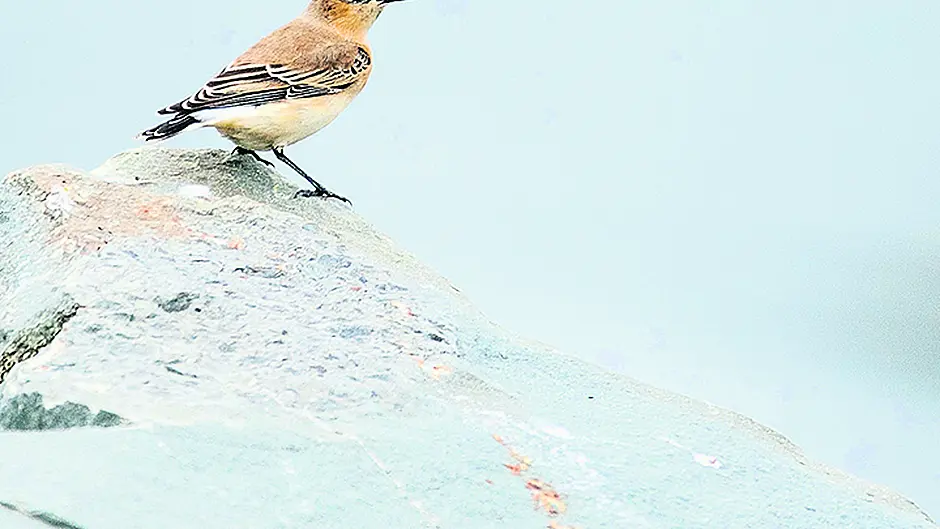I enjoyed a glorious spring day at Toe Head recently with a skylark soundtrack overhead, choughs acrobatically displaying along the cliffs and gannets gleaming in the sunshine.
I enjoyed a glorious spring day at Toe Head recently with a skylark soundtrack overhead, choughs acrobatically displaying along the cliffs and gannets gleaming in the sunshine.
But a much less spectacular bird caught my attention too as the distinctive white rump of the wheatear flitted to and fro on the Máum Rua. This is one of the first of our summer migrants to arrive here, usually in March, after undertaking a long and arduous migration.
Super traveller
Our wheatears come to us from their over-wintering grounds in Africa. However, many wheatear travel even longer distances. Birds that breed in Greenland fly across the Atlantic non-stop to tropical Africa for the winter, a journey of up to 3,200km lasting at least 3 days and nights.
This is one of the longest migrations of any songbird and is a remarkable non-stop flight for a bird not much bigger than a robin.
The fact that all wheatear migrate to Africa (none winter in South America for instance) suggests that the species originated in the Old World and spread to America.
To sustain itself on this mammoth journey, the wheatear has to increase its bodyweight beforehand by up to 50%. This additional load obviously makes it harder to fly and it must also get through its migration without being able to drink.
Once it arrives in Ireland, the wheatear needs to get into breeding condition quickly. In a similar manner to its relative the robin, it feeds from the ground, hopping some distance and then standing bold upright to survey the area around.
Insects are its main food but it will also feed on other invertebrates such as snails, spiders and worms. It favours open habitats with short grass during the breeding season so the headland at Toe Head is ideal territory. Uplands, shingle banks and islands are also good breeding sites for the wheatear.
Wheatears also like areas with drystone walls, scree slopes or abandoned buildings. This is because, unlike other many birds of open grasslands, wheatears need more than a simple tussock to build their nest.
The ideal nesting site is a sheltered hollow at the end of a rocky ‘tunnel’ which can be reached by the birds but is inaccessible to predators such as foxes. Wheatears will also nest in abandoned rabbit burrows.
‘White arse’
The English name wheatear is first recorded around 1600 but it’s believed to have been used long before that. It probably owes its origin to a Middle English word meaning ‘white arse’. The name in Irish, ‘Clochrán’, translates as ‘stone bird’ but the Irish version used in Kerry means ‘the cunning little man under the stone’.
The Latin name is from the Greek meaning ‘grape flower’ and this may owe its origin to the time when wheatears migrated to Greece in spring at the time the grape flower blossoms.
There are a few strange beliefs associated with the wheatear, some of which caused it to be persecuted. It was once believed that toads hatched from wheatear eggs and that these birds contained a drop of the devil’s blood.
There are varying versions of this superstition, (which also applied to stonechat eggs), in different parts of the British Isles. In Ireland, it was thought that wheatears over-wintered underground in a state of hibernation when in reality they left on migration.
Wheatear were once eaten as a delicacy both in Britain and Ireland. They were trapped and roasted, particularly at the end of summer when they had gained weight in preparation for migration, and featured in Mrs Beeton’s famous recipe books.
The wheatear uses raised points such as hummocks and boulders to gain a wider view of grasslands. Folklore has it that if the first sighting of a wheatear is of one standing on a stone, the observer will die shortly afterwards so I am happy to report that my first glimpse of one this year was in the air.
Wheatear was once a common and widespread bird but its numbers are in decline and it is now amber-listed in Ireland. Which is all the more reason to keep an eye out for a white arse on the headlands and dunes of West Cork this summer.








